CyberTAN Technology PW600M Wireless 11g Compact Flash Card User Manual SWU GEG100 Install Manual
CyberTAN Technology Inc. Wireless 11g Compact Flash Card SWU GEG100 Install Manual
Users Manual
SWU-GEG100
54M Compact Flash
Wireless LAN Card
User’s Manual
Rev 0.1

54M Wireless LAN CardBus Card User’s Manual
2
Federal Communication Commission
Interference Statement
This equipment has been tested and found to comply with the limits for a Class B
digital device, pursuant to Part 15 of the FCC Rules. These limits are designed to
provide reasonable protection against harmful interference in a residential installation.
This equipment generates, uses and can radiate radio frequency energy and, if not
installed and used in accordance with the instructions, may cause harmful interference
to radio communications. However, there is no guarantee that interference will not
occur in a particular installation. If this equipment does cause harmful interference to
radio or television reception, which can be determined by turning the equipment off
and on, the user is encouraged to try to correct the interference by one of the following
measures:
- Reorient or relocate the receiving antenna.
- Increase the separation between the equipment and receiver.
- Connect the equipment into an outlet on a circuit different from that
to which the receiver is connected.
- Consult the dealer or an experienced radio/TV technician for help.
This device complies with Part 15 of the FCC Rules. Operation is subject to the
following two conditions: (1) This device may not cause harmful interference, and (2)
this device must accept any interference received, including interference that may
cause undesired operation.
FCC Caution: Any changes or modifications not expressly approved by the party
responsible for compliance could void the user's authority to operate this equipment.
IMPORTANT NOTE:
FCC Radiation Exposure Statement:
This equipment complies with FCC radiation exposure limits set forth for an uncontrolled
environment. End users must follow the specific operating instructions for satisfying RF
exposure compliance.
This transmitter must not be co-located or operating in conjunction with any other
antenna or transmitter.
CyberTAN declared that SWU-GEG100 is limited in CH1~11 from 2400 to 2483.5 MHz
by specified firmware controlled in USA.

54M Wireless LAN CardBus Card User’s Manual
3
About this manual
This User’s Manual describes how to install and operate your Compact Flash
Wireless LAN Card. Please read this manual before you install the product.
This manual includes the following topics:
Product description and features.
Software installation procedure.
Specification

54M Wireless LAN CardBus Card User’s Manual
4
Table of Contents
About this manual ............................................................... 3
Chapter 1 - Introduction................................................... 5
Features............................................................................................ 5
What is Wireless LAN? .................................................................. 6
Wireless LAN Modes...................................................................... 7
Notes on Wireless LAN Configuration ........................................ 8
Chapter 2 – Driver Installation for Windows .................... 9
Driver installation for Windows 2000................................................... 9
Driver installation for Windows XP .................................................... 13
Appendix A – Specifications........................................... 16

54M Wireless LAN CardBus Card User’s Manual
5
Chapter 1 - Introduction
The SWU-GEG100 CF Card gives you the freedom to work your way, from wherever
you want. An enhanced 802.11g featuring advanced silicon chip design from Marvell
capable of delivering data transfer rates up to 54Mbps.Ready to run in Type II
Compact Flash-equipped PDAs running Windows CE, the SWU-GEG100 CF Card is
truly a “must-have” for all PDA users.
Features
• Compact Flash Type-II form factor.
• IEEE 802.11g compatible.
• Backward compatible with IEEE 802.11b standard.
• Wire-free access to networked resources from anywhere beyond the desktop.
• Delivers data rate up to 54 Mbps.
• 802.11g: Dynamically shifts between 54, 48, 36, 24, 18, 12, 9 and 6 Mbps
network speed, based on signal strength, for maximum availability and
reliability of connection.
• 802.11b: Dynamically shifts between 11M, 5.5M, 2M, and 1 Mbps network
speed, based on signal strength, for maximum availability and reliability of
connection.
• Allows users move between Access Points without resetting their connection
reconfiguration.
• Built-In PCB antenna with diversity design (Two antennas required).
• Support advanced power management and power saving mode.
• Low CPU utilization through scatter gathers bus-mastering DMA architecture.
• Uses 2.4GHz frequency band, which complies with worldwide requirement.
• Fallback rat algorithm that sets the optimum transmission rate based on
actual signal-to-noise ratio and packet loss information
• Supports most popular operating systems: Window 98SE/2000/ME/XP and
WinCE/Linux.
• Ensures great security by providing the 64/128 bits Wired Equivalent Privacy
(WEP) and WiFi Protected Access (WPA) defined in the IEEE standard.
• 802.11i and WPA2 Support
• 802.11e (WMM) Support
• Future driver upgradeable

54M Wireless LAN CardBus Card User’s Manual
6
What is Wireless LAN?
Wireless Local Area Network (WLAN) systems offer a great number of
advantages over traditional wired systems. WLAN is flexible and easy to setup
and manage. They are also more economical than wired LAN systems.
Using radio frequency (RF) technology, WLAN transmit and receive data through
the air. WLAN combine data connectivity with user mobility. For example, users
can roam from a conference room to their office without being disconnected from
the LAN.
Using WLAN, users can conveniently access-shared information, and network
administrators can configure and augment networks without installing or moving
network cables.
WLAN technology provides users with many convenient and cost saving features:
• Mobility: WLAN provide LAN users with access to real-time information
anywhere in their organization, providing service opportunities that are
impossible with wired networks.
• Ease of Installation: Installing is easy for novice and expert users alike,
eliminating the need to install network cables in walls and ceilings.
• Scalability: WLAN can be configured in a variety of topologies to adapt to
specific applications and installations. Configurations are easily changed
and range from peer-to-peer networks suitable for a small number of users
to full infrastructure networks of thousands of users roaming over a broad
area.

54M Wireless LAN CardBus Card User’s Manual
7
Wireless LAN Modes
Wireless LANs can be configured in one of two ways:
Ad-hoc
Networking
Also known as a peer-to-peer network, an ad-hoc
network is one that allows all workstations and
computers in the network to act as servers to all other
users on the network. Users on the network can share
files, print to a shared printer, and access the Internet
with a shared modem. However, with ad-hoc
networking, users can only communicate with other
wireless LAN computers that are in the wireless LAN
workgroup, and are within range.
Infrastructure
Networking
Infrastructure networking differs from ad-hoc
networking in that it includes an access point. Unlike
the ad-hoc structure where users on the LAN contend
the shared bandwidth, on an infrastructure network the
access point can manage the bandwidth to maximize
bandwidth utilization.
Additionally, the access point enables users on a
wireless LAN to access an existing wired network,
allowing wireless users to take advantage of the wired
networks resources, such as Internet, email, file
transfer, and printer sharing.
Infrastructure networking has the following advantages
over ad-hoc networking:
• Extended range: each wireless LAN computer
within the range of the access point can
communicate with other wireless LAN computers
within range of the access point.
• Roaming: the access point enables a wireless
LAN computer to move through a building and still
be connected to the LAN.
• Wired to wireless LAN connectivity: the access
point bridges the gap between wireless LANs and
their wired counterparts.

54M Wireless LAN CardBus Card User’s Manual
8
Notes on Wireless LAN Configuration
When configuring a wireless LAN (WLAN), be sure to note the following points:
• Optimize the performance of the WLAN by ensuring that the distance
between access points is not too far. In most buildings, WLAN Adapters
operate within a range of 100 ~ 300 feet, depending on the thickness and
structure of the walls.
• Radio waves can pass through walls and glass but not metal. If there is
interference in transmitting through a wall, it may be that the wall has
reinforcing metal in its structure. Install another access point to circumvent
this problem.
• Floors usually have metal girders and metal reinforcing struts that interfere
with WLAN transmission.
This concludes the first chapter. The next chapter deals with the hardware
installation of the Adapter.
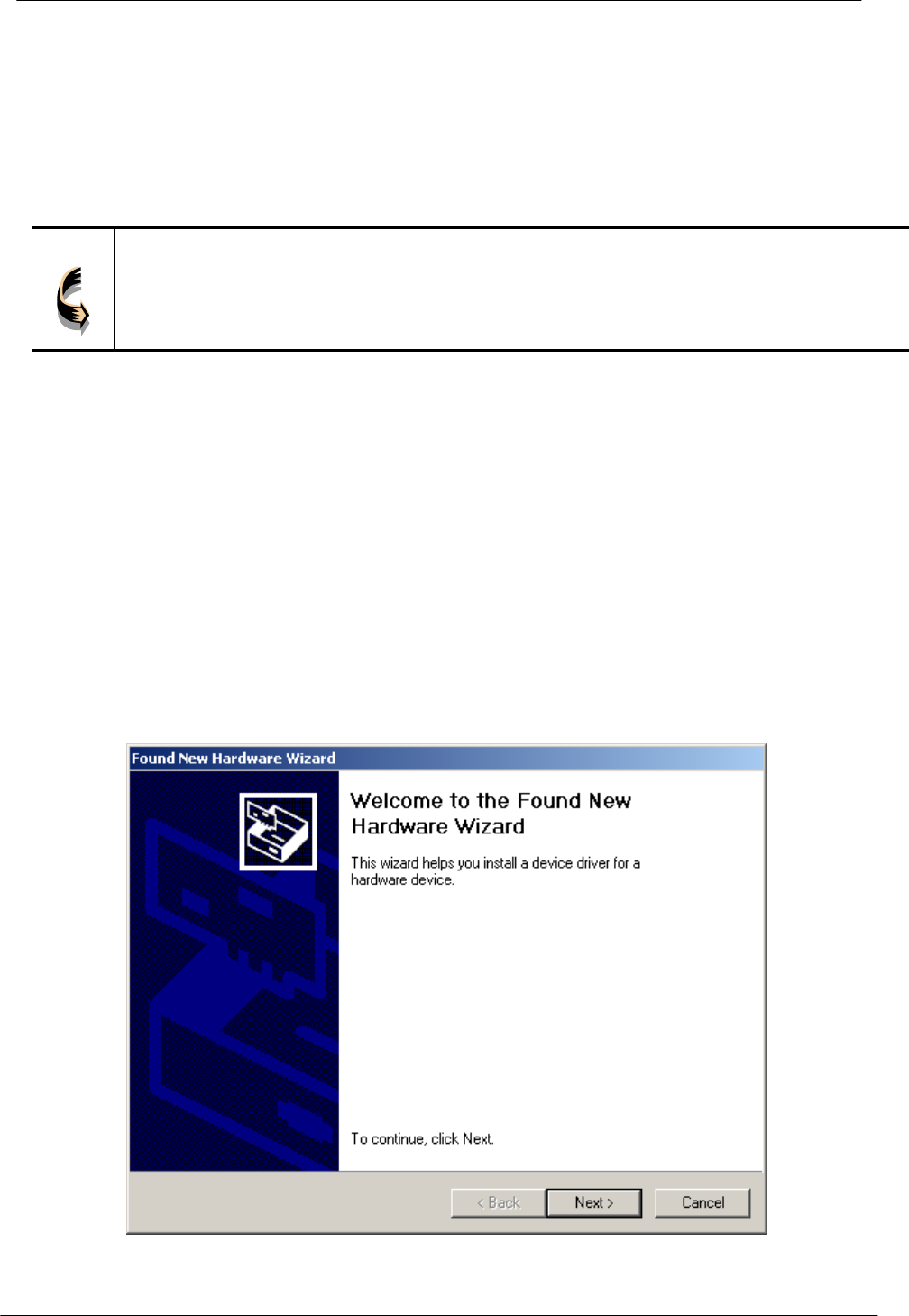
54M Wireless LAN CardBus Card User’s Manual
9
Chapter 2 – Driver Installation for Windows
The following sections cover Compact Flash Wireless LAN Card driver installation in the
Windows Operating Systems.
Note!
You have to install your hardware first before you begin to install the drivers.
Please use extensible card to extend Compact Flash card to Card Bus.
Driver installation for Windows 2000
Follow the steps below to install the Compact Flash Wireless LAN Card drivers for
Windows 2000.
1. Insert the SWU-GEG100 to CardBus slot of notebook first.
2. After Windows 2000 detects the Compact Flash Wireless LAN Card, the Found
New Hardware Wizard window appears. Click Next to start the installation.
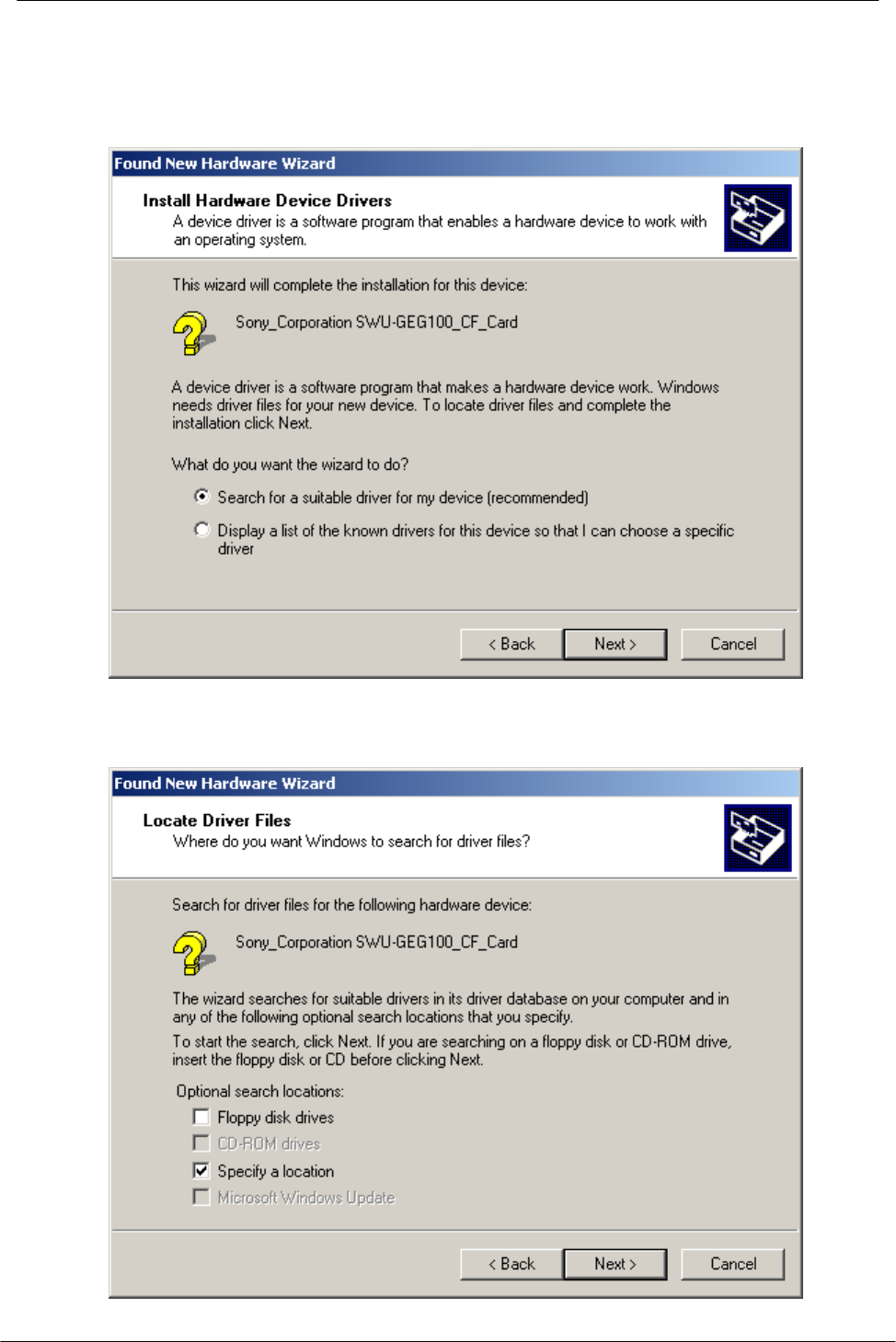
54M Wireless LAN CardBus Card User’s Manual
10
3. A screen appears prompting you to select an installation method. Select Search
for a suitable driver for my device (recommended) and click Next to continue.
4. Ensure that the driver is copied to the PC.
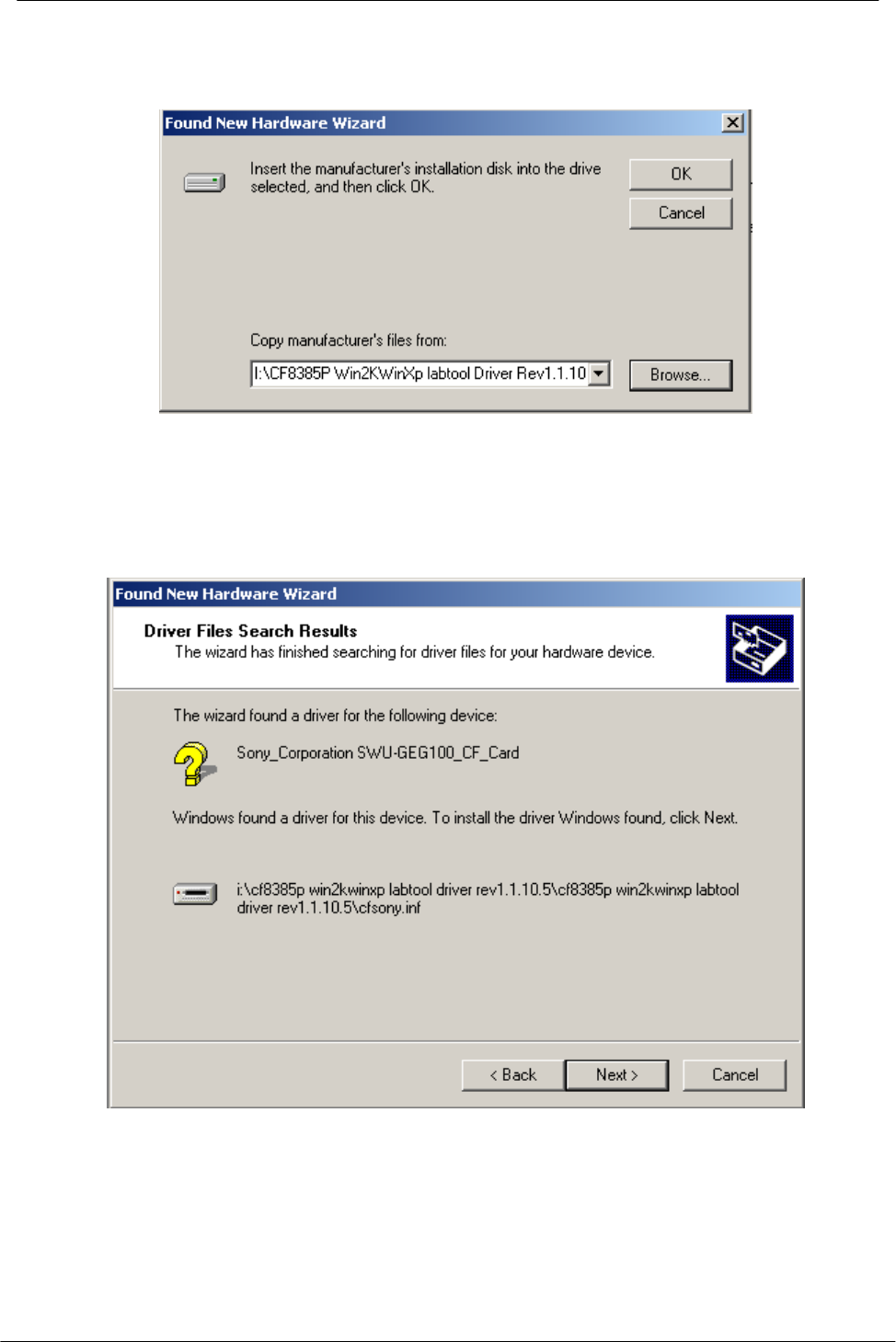
54M Wireless LAN CardBus Card User’s Manual
11
5. Click Browse button to point to the driver location.
6. The following screen appears showing the driver search result. Click Next to
continue the installation.
7. The following screen appears. Click Yes to continue
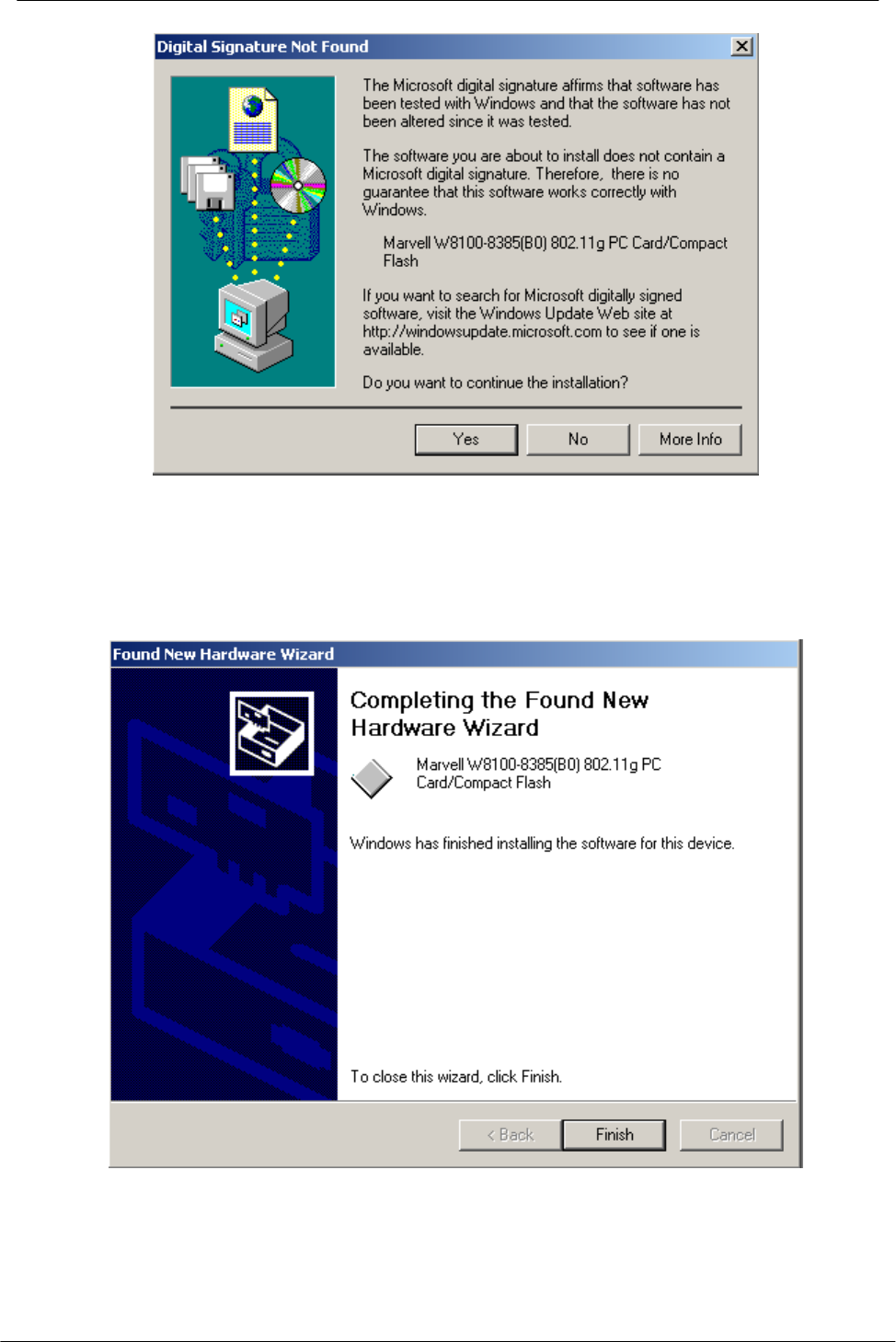
54M Wireless LAN CardBus Card User’s Manual
12
8. The Windows has finished installing software for the device. Click Finish to finish
the installation.
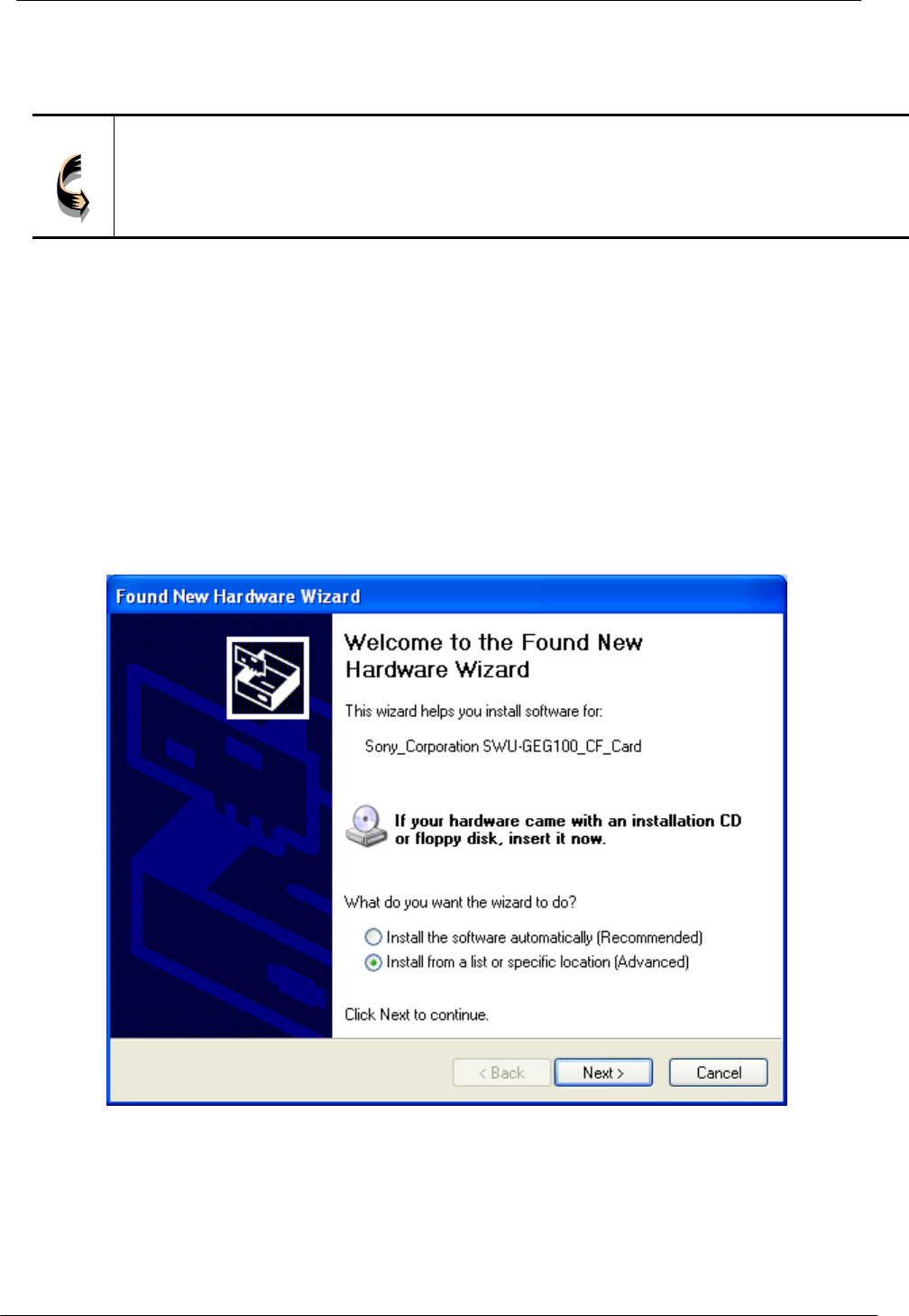
54M Wireless LAN CardBus Card User’s Manual
13
Driver installation for Windows XP
Note!
You have to install your hardware first before you begin to install the drivers.
Please use extensible card to extend Compact Flash card to Card Bus.
Follow the steps below to install the Compact Flash Wireless LAN Card drivers for
Windows XP.
1. Insert the SWU-GEG100 to CardBus slot of notebook first.
2. After Windows XP detects the SWU-GEG100, the Found New Hardware Wizard
window appears. Select Install from a list or specific location (Advanced) and
copy the driver to the PC and click Next to continue.
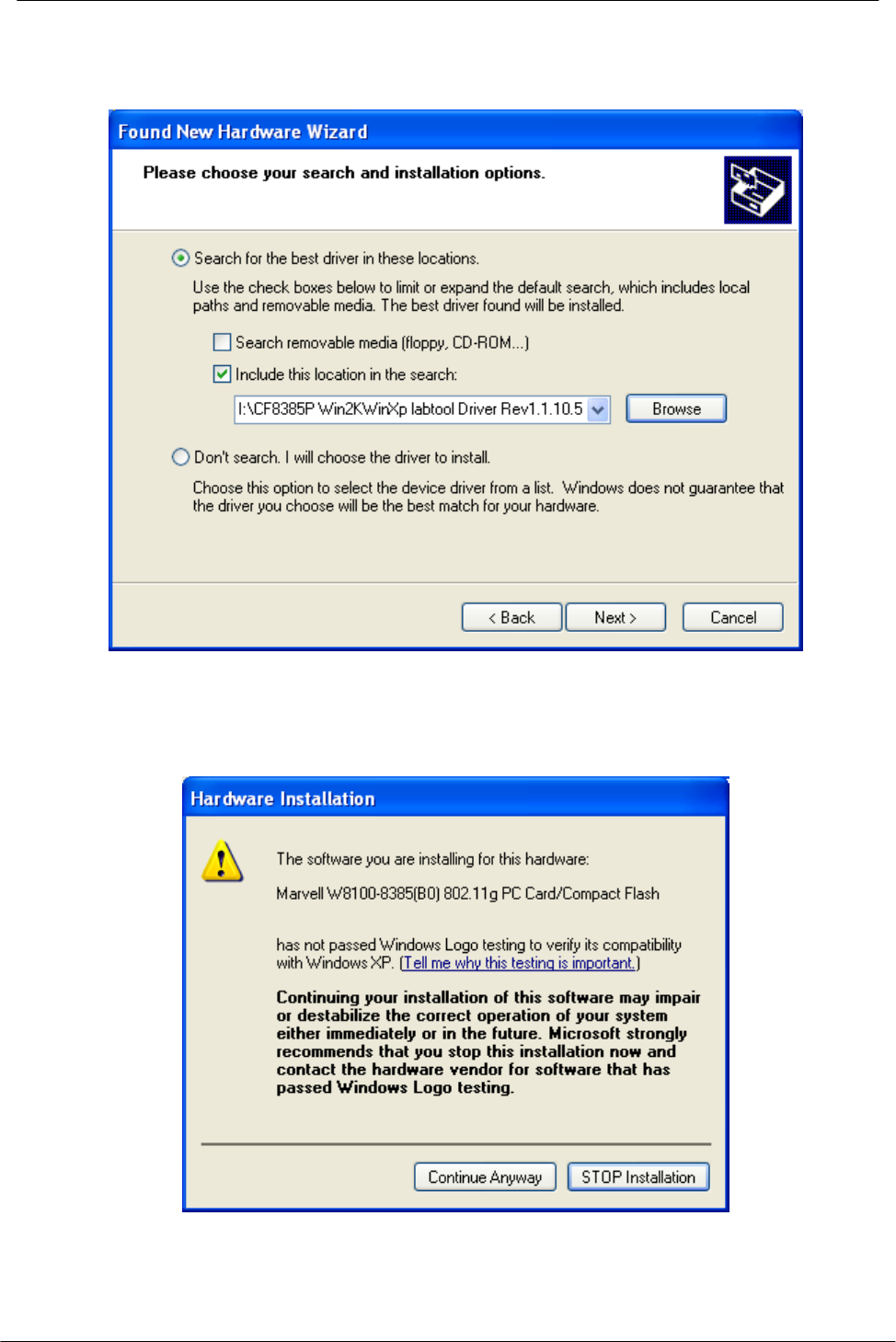
54M Wireless LAN CardBus Card User’s Manual
14
3. Click Browse button to point to the driver location and click Next.
4. Click Continue Anyway to continue the installation.
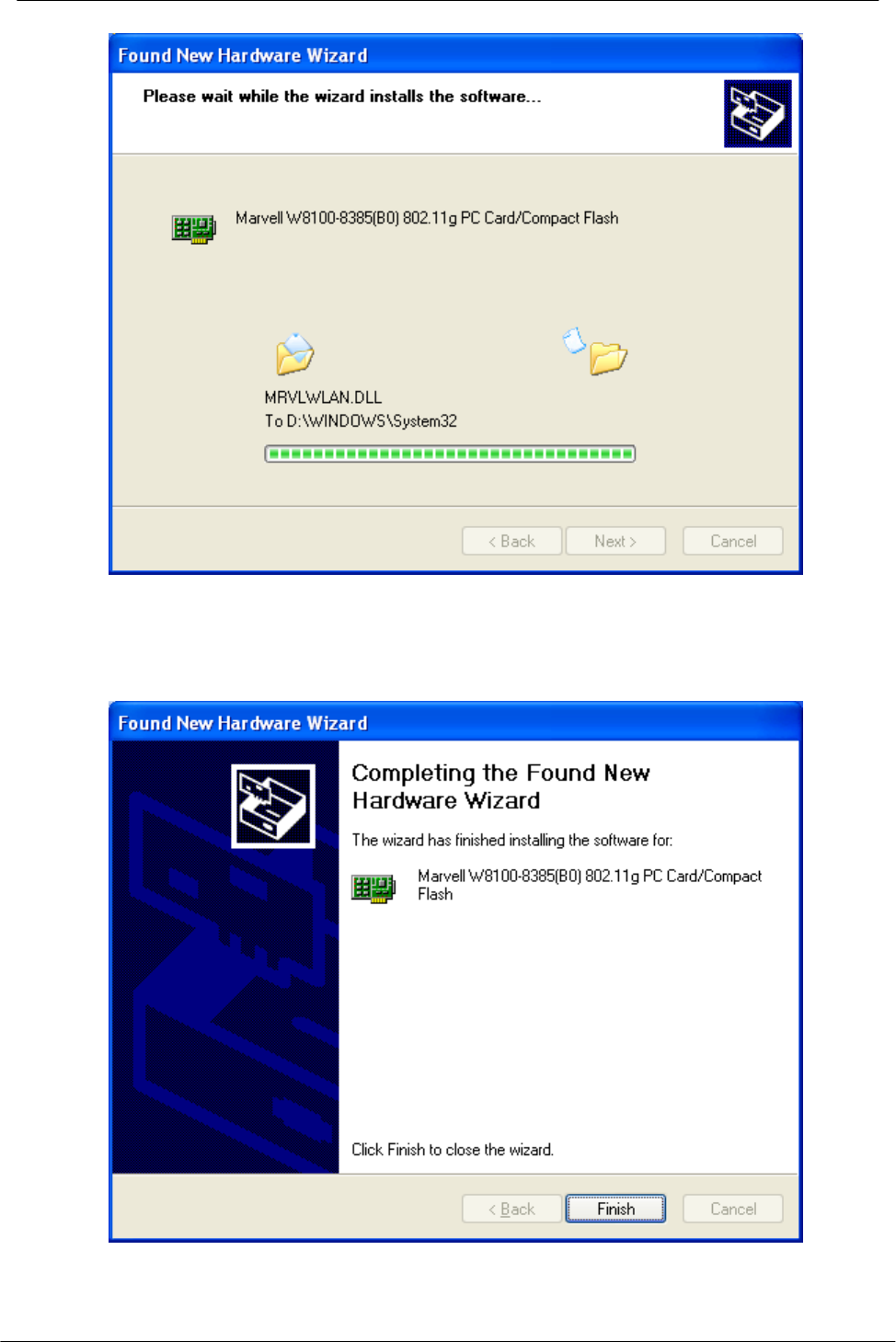
54M Wireless LAN CardBus Card User’s Manual
15
5. The Windows has finished installing software for the device. Click Finish to finish
the installation

54M Wireless LAN CardBus Card User’s Manual
16
Appendix A – Specifications
Specifications
Product Name 802.11g WLAN CF Card
Interface Compact Flash Type-II
Network Standard IEEE802.11g/b COMPLIANCE
Data Rate 54Mbps with automatic fallback to 48, 36, 24,18,12,9 and 6 Mbps
Modulation 802.11g---- 54, 48, 36,24,18,12,9,6Mbps (OFDM)
802.11b---- CCK (11Mbps, 5.5Mbps), QPSK (2Mbps), BPSK (1Mbps)
Technique Direct Sequence Spread Spectrum
Operating Frequency 2.412 ~ 2.462 GHz: North America
2.412 ~ 2.472 GHz: Europe ETSI and
2.412 ~ 2.472 GHz: Japan (ARIB STD-T66)
Operating Channels 1~11 for N. America, 1~13 for Europe (ETSI) and Japan,
RF Output Power 8 dBm (54Mbps, OFDM, typical)
9 dBm (11Mbps, CCK, QPSK, BPSK, typical)
Antenna Built-In PCB antenna with diversity.
LED Indicators PWR----Power
ACT--- Active
Indoor:
20M@54Mbps,
35M@24Mbps,
60M@6Mbps,
100M@11Mbps
Coverage Area
Outdoor:
40M@54Mbps,
55M@48Mbps,
75M@36Mbps,
100M@24,18,12,9,6Mbps,
60M@11Mbps,
100M@5.5Mbps,
150M@2Mbps,
250M@1Mbps
EVM EVM = -27dB @ OFDM
EVM = 12%ms @ CCK
Frequency Accuracy Sub-carrier Frequency ± 20KHz
Receiver Sensitivity
-72 dBm @ 54M OFDM, 10% PER
-88 dBm @ 11M CCK, 7% PER
-83 dBm @ 6Mbps OFDM, 10% PER
-91 dBm @ 1Mbps DBPSK, 7% PER
Power Consumption at
Duty-Cycle Mode
TX power consumption Peak: 465mA @ OFDM
RX power consumption Peak: 240mA @ OFDM
TX power consumption Peak: 480mA @ CCK
RX power consumption Peak: 240mA @ CCK
Non-Active Peak: 225mA
Power Saving Mode: Not available at this moment
Antenna Gain -4~0 dBi

54M Wireless LAN CardBus Card User’s Manual
17
Support OS Microsoft Windows 98(SE), Windows 2K, Windows XP, Windows ME,
Windows CE 3.0 / 4.0 / 5.0
Linux Kernel 2.4.16 and above.
Operating Temperature 0 to 55 ℃
Humidity 20% to 95% Non-condensing
Dimensions (mm) (W) 58.95mm × (D) 42.8mm × (H) 3.3mm
Weight (g) 30g
Voltage 3.3V